Types of AlcoholFor thousands of years, people have consumed alcohol. Alcohol is both a chemical and a psychoactive drug. Alcohol is formed when a hydroxyl group (a pair of oxygen and hydrogen atoms) tries to replace the hydrogen atom in a hydrocarbon. Secondary alcohols are formed when alcohols react with other atoms. There are numerous alcoholic beverages, some containing significantly more alcohol than others. 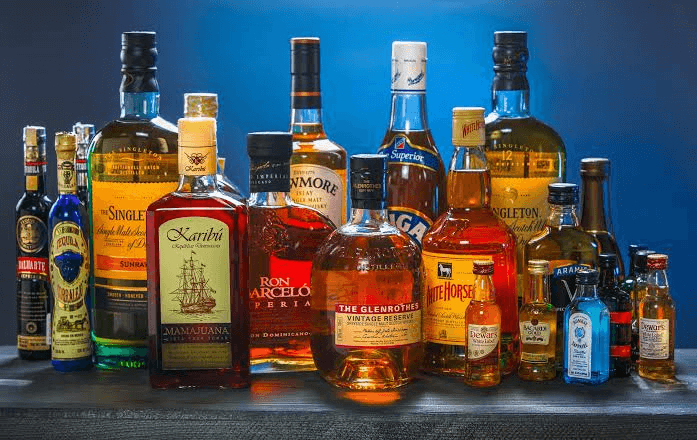
Most countries allow alcohol to be consumed legally and over a hundred countries have laws governing their production, sale and consumption. These laws establish the legal age for buying or consuming alcohol. Depending on the country and the type of drink, the minimum drinking age ranges from 15 to 21 years. Most countries set the age at 18. Higher alcohol concentration levels in alcoholic beverages can start causing drunkenness and alcohol poisoning even by taking smaller amount. Methanol, isopropanol, and ethanol are the three types of alcohol that are regularly consumed. What is Alcohol?Anyone who has been to a grocery store is aware that there are various types of alcohol available. Some alcohols are distilled, which increases their concentration and makes them more dangerous. The intoxicating ingredient in beer, wine, and spirits is alcohol. Secondary alcohols include methanol, isopropanol, and ethanol. Even though all three types of alcohol are toxic, only ethyl alcohol is safe to consume. The other two are used in washing and industrial production. Consuming any amount of isopropanol or methanol is extremely dangerous and can be fatal. Why is Alcohol So Popular?It is crucial to understand that being popular and being socially acceptable are two different things. Alcohol is popular because it is used as a necessary liquid for relaxing or having fun. Many Americans associate with alcohol in social situations such as parties, celebrations, or barbecues. Some people might even think that in order to relax and have fun, they need to drink alcohol. 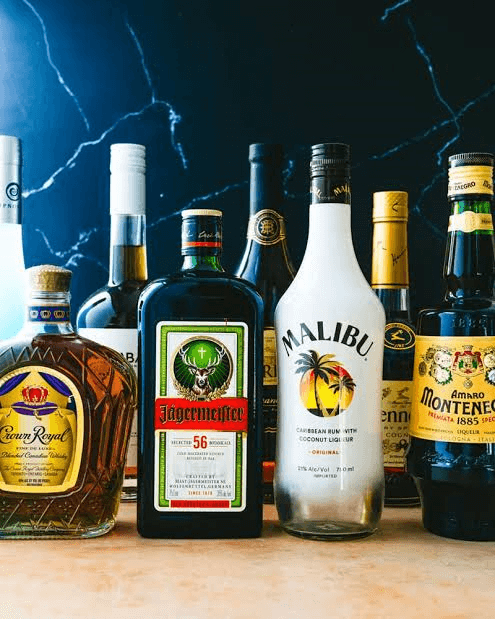
Alcohol is promoted as a coping mechanism in society. For example, "relax with a glass of wine, it'll take the edge off," one might say. Some people believe that certain types of combinations such as cheese and wine or pizza and beer, are ideal for food pairing. Of course, these are just a few of the reasons why alcohol is so popular in the United States. Almost half of the population consumes alcohol. Alcohol's widespread popularity can make life challenging for people who are addicted to it. Alcoholics may find themselves in social situations where they feel pressured to drink. Why is Alcohol Classified as a Drug?Even though it may not seem like it alcohol is classified as a drug. This is due to the fact that when alcohol is consumed to the body it has a psychological effect. It is a legal drug for anyone of drinking age. Types of AlcoholThe only alcoholic beverage that people can consume without harm is ethanol. Methanol (or methyl alcohol) can be found in gasoline and boat fuel, among other things. It's also used in producing antifreeze, paint remover, windscreen washer fluid, and various other products. Rubbing alcohol is the chemical name for isopropanol (or isopropyl alcohol), which is used for cleaning and disinfecting. 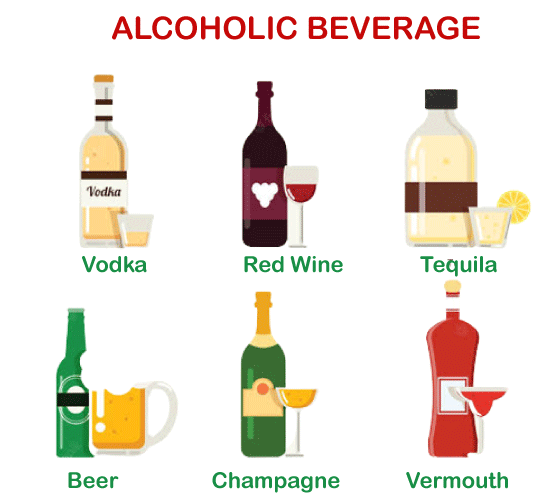
Methanol and isopropanol are both toxic to humans because they deform into toxic components that can lead liver failure. Even trace amounts of rubbing alcohol or methanol can indeed be lethal. Ethanol is a colourless, volatile, flammable liquid with a pungent taste and a wine-like odor. It is the main chemical in alcoholic beverages and is a psychoactive recreational drug. 1. Isopropyl AlcoholIsopropyl alcohol is also known as rubbing alcohol . Its primary application is sterilisation. This alcohol is used to disinfect clean surfaces, tools, and human skin. This alcohol is present in cleaning products as well as trace amounts in cosmetics and lotions. 2. Methyl AlcoholMethyl alcohol is also known as wood alcohol which is commonly used in manufacturing. It can be used to make paint remover or antifreeze, and its by-products range from plastics to explosives. This type of alcohol in addition to keeping other fuels from freezing it is used to refuel vehicles such as cars and boats. 3. Ethyl AlcoholEthyl alcohol (grain alcohol) is produced through the fermentation of sugars, yeast, and starches. Because of its ability to change mood and behaviour, this type of alcohol has been considered a hard drug for thousands of years. In fact, ethanol has several negative effects on the body, including throat damage and damage to the liver, kidney, and brain. In the central nervous system, ethanol impairs coordination and judgement. Alcohol addiction, such as binge drinking or heavy drinking, can lead to health problems and alcohol addiction. Alcohol withdrawal can be fatal for people who are physically dependent on it. Uses of Alcohol
Undistilled and Distilled AlcoholAlcoholic beverages are classified into two types those are undistilled alcohol and distilled alcohol. Undistilled beverages are also referred to as fermented beverages. Fermentation is the chemical process by which bacteria or yeast convert sugar to ethanol. Wine and beer are both produced by fermentation, undistilled alcoholic beverages. Fermenting grapes yields wine, whereas fermenting barley, wheat, or other grains yields beer. Distillation occurs after fermentation. Distillation differentiates alcohol from water and other substances of a fermented material to concentrate it. This method converts a fermented substance into a higher alcohol concentration. Spirits and liquors are alcoholic beverages that are distilled. They contain more alcohol than non-distilled beverages. A distilled alcoholic beverage generally has a higher alcohol proof. 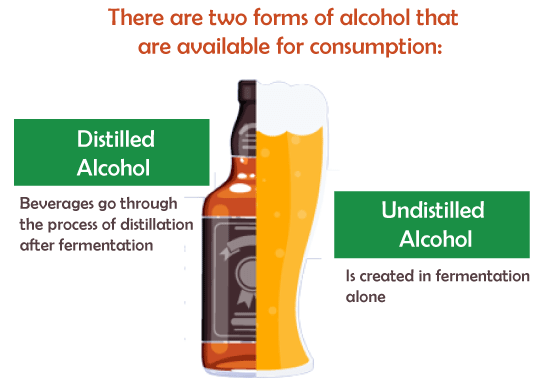
Alcohol by volume (ABV) and alcohol proof are two ways to calculate the amount of alcohol in a drink. Alcohol by volume is the amount of ethanol in millilitres per 100 millilitres (or 3.4 fl.oz.) of solution, whereas alcohol proof is twice the percentage of alcohol by volume. A drink with 50% ABV, for example, will be 100 proof. Undistilled Beverage ClassificationsWine and beer are the most popular undistilled alcoholic beverages, and they have been produced and consumed for thousands of years. They have a lesser ABV and proof than distilled drinks, implying that a greater volume is required to become intoxicated. While undistilled alcohol has a lower ABV than distilled alcohol, it can still cause alcohol poisoning or other health risks, as well as addiction. 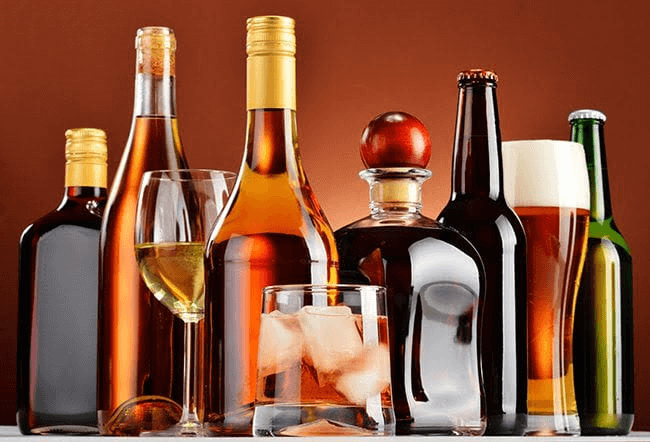
Beer is the world's third most popular beverage after water and tea which is considered as the oldest beverage ever reported worldwide. Most beers are available in larger or ale sizes, with an ABV ranging from 4 to 6% on average. Light beers typically have an ABV of 2 to 4%, whereas malt liqueurs and strong lagers can have up to 12%.
Wine is another ancient beverage that comes in a wide varieties from all over the world. The most common wines are red, white, and rose with ABVs ranging from 12 to 14%. Vermouth, port, and Madeira are fortified wines that use distilled alcohol to increase the alcohol by volume (ABV), which is typically around 20%. Champagne, prosecco, cava, and other sparkling wines are carbonated and have an alcohol content ranging from 10 to 12% ABV.
Sake is a fermented rice-based alcoholic beverage from Japan. It has a higher ABV than other undistilled alcohols, typically between 16 and 18%.
Cider is also known as hard cider which is made in the same way of beer but with fermented apple juice. Cider typically has an ABV of around 5%, but there are also light and strong varieties.
Mead is an ancient Egyptian drink made of water and fermented honey with an alcohol by volume (ABV) ranging from 10% to 14%. Distilled Beverage ClassificationsDistilled spirit also known as distilled liquor which is an alcoholic beverage produced by distillation from wine or other fermented fruit, plant juice, or a starchy substance (such as various grains). 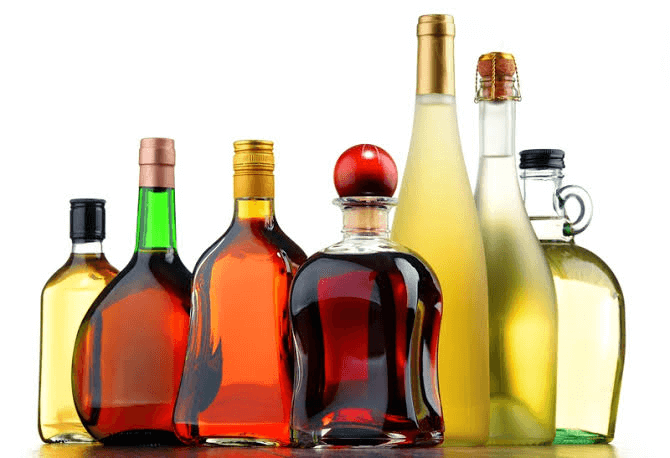
Gin is distilled from juniper berries and other botanicals. The ABV ranges from 35 to 60%.
Brandy is a fortified wine that is stronger than other types of distilled wine. Cognac is the most well-known brand, with an ABV of 40%, and other brands range from 35 to 60%.
Whisky is a spirit made from fermented grain that originated in Scotland, but it is now produced worldwide with many different varieties. Whisky typically has an ABV ranging from 40 to 55%.
Rum is made from fermented sugarcane or molasses and comes in dark, white, and spiced varieties. Rum has an average alcohol by volume (ABV) of 40%, with over-proofed versions ranging from 57.5 to 75.5%.
Tequila is a Mexican alcoholic beverage made from fermented agave (cactus). The beverage is typically clear or golden in colour, but it can be flavoured by combining it with other ingredients. Tequila's ABV ranges from 40% to 60%.
Vodka was invented in Russia and other Eastern European countries, and it is usually prepared by distilling a fermentation process with grains and potatoes to produce a clear finish. The standard concentration of vodka is 40% but some drinks such as tequila can reach 60%.
Absinthe was previously prohibited due to its purported hallucinogenic properties. It is produced from fermented herbs and needs to leave and usually does have a vivid green colour, leading to the given name "the green fairy". Although some producers still produce 90% varieties It is commonly sold with a 40% ABV. EverclearEverclear is a grain-based alcohol having one of the highest ABVs of any alcoholic beverage, typically ranging from 60% to 95%. These are also referred to as ETOH alcoholic beverages. Other Alcoholic ProductsWhile traditional distilled and undistilled alcohol is still the most commonly consumed form the substance, it can be found in a variety of products. Some of these have sparked controversy due to their appeal to children and lax regulations. The following are among the most common alcohol-containing products Alcoholic Energy DrinksAlcoholic beverages have existed for over a decade, but stricter regulations have resulted in the drinks being forbidden or re-branded. The most prominent example was Four Loko, despite having 12% ABV it was marketed as an energy drink until it was banned in 2010 and later introduced as a primarily alcoholic beverage.
Kombucha typically has less than 0.5% ABV, allowing it to be marketed to those who are under the age of 21 as alcohol-free beverage. Moreover, there are types of drinks with greater alcohol by volume level that are only available to those over the age of 21.
Powdered alcohol, also known as dry alcohol or crystalline alcohol which is created through a complex chemical process called microencapsulation, which utilises sugars to absorb alcohol. Regulators are concerned about the inability to manage ABV levels when the powder is mixed with liquid to make it alcoholic.
In recent years, hard seltzers like White Claw have become increasingly popular as a lower-alcohol alternative to other beverages. This made them popular among young people and teenagers despite the popular belief that they do not get you drunk, which is false. Drink with Caution.Tolerance, dependence, and addiction to alcohol can develop quickly, altering the chemical balance of the brain to the point where the alcohol is required to function or feel normal. People who drink irresponsibly such as excessive drinking, increase their risk of dependence and addiction to alcohol. 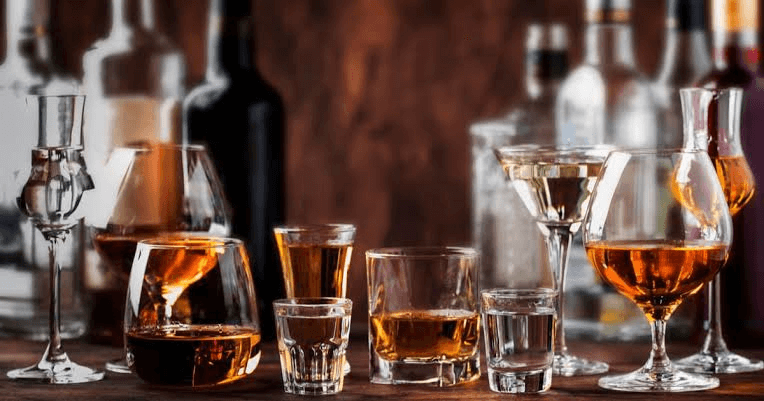
Furthermore, because alcohol is so widely accepted in society many people are unaware that they are developing a problem. According to the Centres for Disease Control and Prevention, alcohol poisoning kills about 'six people daily'. Despite its harmful effects and potential for death, drinking is still socially acceptable. It is time to seek help if you or someone you care about has hardships with alcohol and could have a drinking problem. These suggestions can assist in reducing alcohol consumption and controlling the urge to drink.
Next TopicFirst 20 Elements
|
 For Videos Join Our Youtube Channel: Join Now
For Videos Join Our Youtube Channel: Join Now
Feedback
- Send your Feedback to [email protected]
Help Others, Please Share









